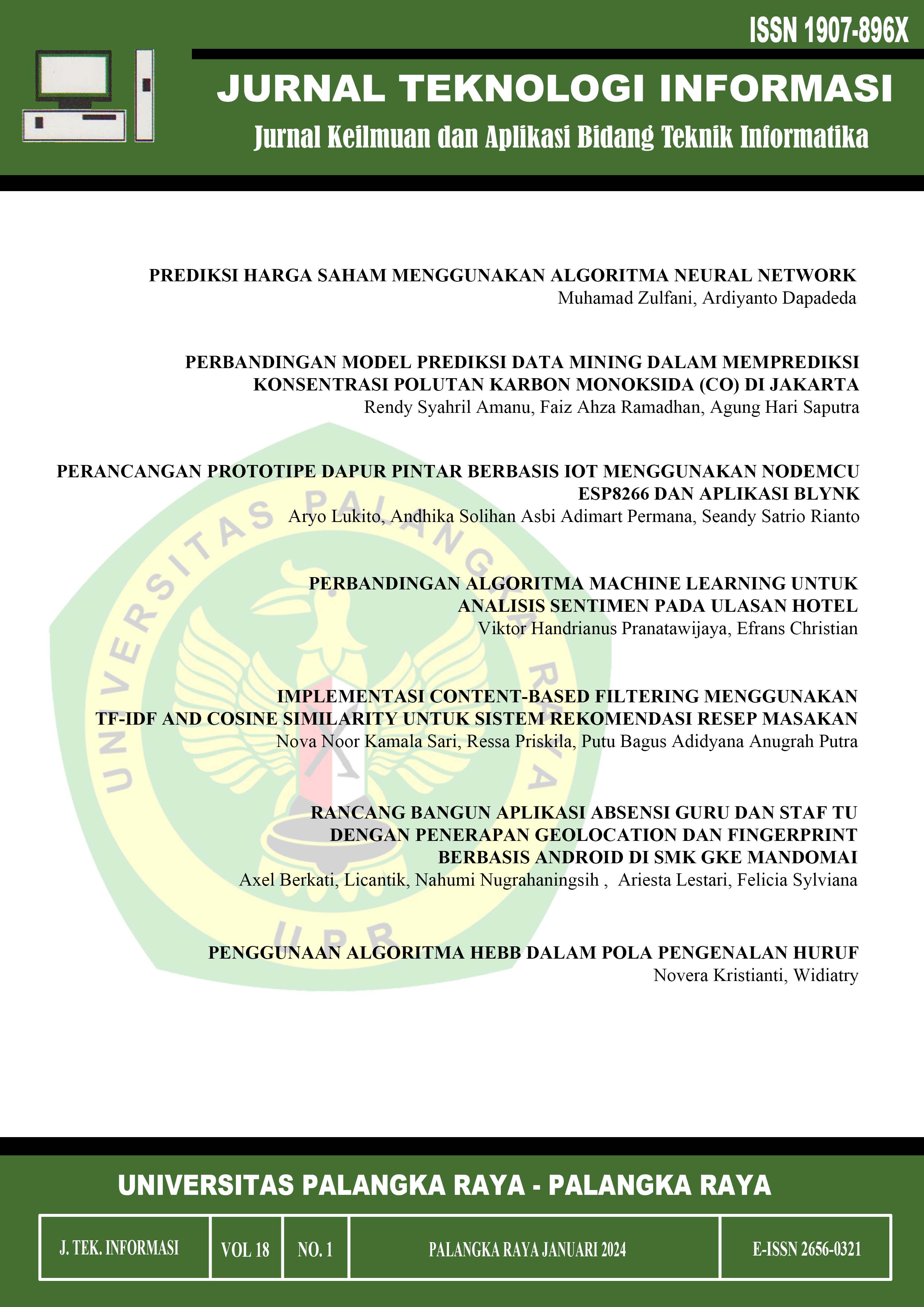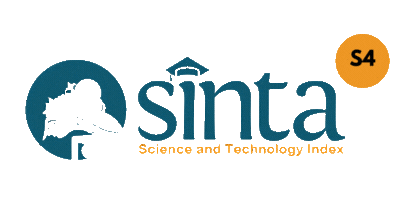PERBANDINGAN MODEL PREDIKSI DATA MINING DALAM MEMPREDIKSI KONSENTRASI POLUTAN KARBON MONOKSIDA (CO) DI JAKARTA
DOI:
https://doi.org/10.47111/jti.v18i1.12451Keywords:
Pemodelan, Prediksi, Karbon monoksida, Data miningAbstract
DKI Jakarta, as the capital of Indonesia, faces serious challenges in terms of air quality. Carbon monoxide (CO) is one of the main air pollutants in Jakarta that is harmful to human health and the environment. Data mining is a method that can be used to predict situations based on a model. The study aims to compare data mining models with the best-performing methods to predict carbon monoxide pollutants in Jakarta. The predictive data mining model of the python library is tested and evaluated based on the evaluation metrics of MASE, RMSSE, MAE, RMSE, MAPE and SMAPE values. The model test results showed that K Neighbors with the Conditional Deseasonalize & Detrending model had the best metric evaluation value to predict CO concentration with the value evaluation metrics of MASE 0.2942, RMSSE 0.2483, MAE 2.7362, RMSE 3.3863, MAPE 0.1975 and SMAPE 0.01993. Overall, K Neighbors with the Conditional Deseasonalize & Detrending model shows good performance to predict CO concentrations in Jakarta, but further adjustments are needed to improve accuracy.
Downloads
References
Abidin, A. R., Kadek, I., & Nuryana, D. (2023). Perbandingan Metode Klasifikasi Data Mining Untuk Mengukur Tingkat Kepuasan Mahasiswa Terhadap Sistem Informasi Penilaian Nonakademik UNESA (SIPENA). Journal of Emerging Information Systems and Business Intelligence, 04(04), 129–138.
Amalia, A., Zaidiah, A., & Isnainiyah, I. N. (2022). PREDIKSI KUALITAS UDARA MENGGUNAKAN ALGORITMA K-NEAREST NEIGHBOR. Jurnal Ilmiah Penelitian dan Pembelajaran Informatika, 07(02), 465–507. https://data.jakarta.go.id/.
Anwar, M. T., & Permana, D. R. A. (2021a). Perbandingan Performa Model Data Mining untuk Prediksi Dropout Mahasiwa. Jurnal Teknologi dan Manajemen, 19(2), 33–40. https://doi.org/10.52330/jtm.v19i2.34
Anwar, M. T., & Permana, D. R. A. (2021b). Perbandingan Performa Model Data Mining untuk Prediksi Dropout Mahasiwa. Jurnal Teknologi dan Manajemen, 19(2), 33–40. https://doi.org/10.52330/jtm.v19i2.34
Astriyani, M., Laela, I. N., Lestari, D. P., Anggraeni, L., & Astuti, T. (2022). ANALISIS KLASIFIKASI DATA KUALITAS UDARA DKI JAKARTA MENGGUNAKAN ALGORITMA C.45. JURNAL SISTEM & TEKNOLOGI INFORMASI KOMUNIKASI, 6(1), 36–41.
Botchkarev, A. (2018). Evaluating Performance of Regression Machine Learning Models Using Multiple Error Metrics in Azure Machine Learning Studio. SSRN Electronic Journal. https://doi.org/10.2139/ssrn.3177507
Chicco, D., Warrens, M. J., & Jurman, G. (2021a). The coefficient of determination R-squared is more informative than SMAPE, MAE, MAPE, MSE and RMSE in regression analysis evaluation. PeerJ Computer Science, 7, e623. https://doi.org/10.7717/peerj-cs.623
Chicco, D., Warrens, M. J., & Jurman, G. (2021b). The coefficient of determination R-squared is more informative than SMAPE, MAE, MAPE, MSE and RMSE in regression analysis evaluation. PeerJ Computer Science, 7, e623. https://doi.org/10.7717/peerj-cs.623
Damara, D. Y., Wardhana, I. W., & Sutrisno, E. (2017). ANALISIS DAMPAK KUALITAS UDARA KARBON MONOKSIDA (CO) DI SEKITAR JL. PEMUDA AKIBAT KEGIATAN CAR FREE DAY MENGGUNAKAN PROGRAM CALINE4 DAN SURFER (STUDI KASUS: KOTA SEMARANG). Jurnal Teknik Lingkungan, 6(1).
Hyndman, R. J., & Koehler, A. B. (2006). Another look at measures of forecast accuracy. International Journal of Forecasting, 22(4), 679–688. https://doi.org/10.1016/j.ijforecast.2006.03.001
IQAir. (2019). 2019 WORLD AIR QUALITY REPORT Region & City PM2.5 Ranking.
Kamagi, D. H., & Hansun, S. (2014). Implementasi Data Mining dengan Algoritma C4.5 untuk Memprediksi Tingkat Kelulusan Mahasiswa. Jurnal ULTIMATICS, 6(1), 15–20. https://doi.org/10.31937/ti.v6i1.327
Kendek, O. J., Prang, J. D., & Paendong, M. (2014). Prediksi Jumlah Pengunjung Perpustakaan Universitas Sam Ratulangi Manado Menggunakan Metode Dekomposisi. d’CARTESIAN, 3(1), 73. https://doi.org/10.35799/dc.3.1.2014.4000
Kolassa, S. (2016). Evaluating predictive count data distributions in retail sales forecasting. International Journal of Forecasting, 32(3), 788–803. https://doi.org/10.1016/j.ijforecast.2015.12.004
Lubis, I. (2018). ANALISIS MODEL VOLATILITAS INDEKS DAN NILAI MATA UANG DI ASIA TENGGARA. Jurnal Madani : Ilmu Pengetahuan, Teknologi dan Humaniora, 1(1), 123–142. https://doi.org/10.33753/madani.v1i1.7
Makridakis, S. (1993). Accuracy measures: theoretical and practical concerns. International Journal of Forecasting, 9(4), 527–529. https://doi.org/10.1016/0169-2070(93)90079-3
Mayadewi, P., & Rosely, E. (2015). PREDIKSI NILAI PROYEK AKHIR MAHASISWA MENGGUNAKAN ALGORITMA KLASIFIKASI DATA MINING. Seminar Nasional Sistem Informasi Indonesia, 329–334.
Moez Ali. (2020, April). PyCaret: An open source, low-code machine learning library in Python. PyCaret version 1.0. https://www.pycaret.org
Muzakir, A., & Wulandari, R. A. (2016). Model Data Mining sebagai Prediksi Penyakit Hipertensi Kehamilan dengan Teknik Decision Tree. Scientific Journal of Informatics, 3(1). http://journal.unnes.ac.id/nju/index.php/sji
Nugroho, A., Asror, I., & Wibowo, Y. F. A. (2023). Klasifikasi Tingkat Kualitas Udara DKI Jakarta Berdasarkan Open Government Data Menggunakan Algoritma Random Forest. e-Proceeding of Engineering, Vol.10, No.2, 1824.
Nurani, A. T., Setiawan, A., & Susanto, B. (2023). Perbandingan Kinerja Regresi Decision Tree dan Regresi Linear Berganda untuk Prediksi BMI pada Dataset Asthma. Jurnal Sains dan Edukasi Sains, 6(1), 34–43. https://doi.org/10.24246/juses.v6i1p34-43
Portal Data Terpadu Pemprov DKI Jakarta. (t.t.). Open Data Jakarta. Diambil 29 Desember 2023, dari https://data.jakarta.go.id/
Purbolaksono, M. D., Irvan Tantowi, M., Imam Hidayat, A., & Adiwijaya, A. (2021). Perbandingan Support Vector Machine dan Modified Balanced Random Forest dalam Deteksi Pasien Penyakit Diabetes. Jurnal RESTI (Rekayasa Sistem dan Teknologi Informasi), 5(2), 393–399. https://doi.org/10.29207/resti.v5i2.3008
Qomariah, S., Ekawati, H., & Belareq, S. (2020). IMPLEMENTASI METODE DATA MINING APRIORI PADA APLIKASI PENJUALAN PT. TIGA RAKSA SATRIA. Komputasi: Jurnal Ilmiah Ilmu Komputer dan Matematika, 17(1), 329–338. https://doi.org/10.33751/komputasi.v17i1.1747
Sang, A. I., Sutoyo, E., & Darmawan, I. (2021). ANALISIS DATA MINING UNTUK KLASIFIKASI DATA KUALITAS UDARA DKI JAKARTA MENGGUNAKAN ALGORITMA DECISION TREE DAN SUPPORT VECTOR MACHINE DATA MINNING ANALYSIS FOR CLASSIFICATION OF AIR QUALITY DATA DKI JAKARTA USING DECISION TREE ALGORTHM AND SUPPORT VECTOR MACHINER ALGORITHM. e-Proceeding of Engineering, 8(5), 8954–8963.
Satyawati, N. M. W., Candiasa, I. M., & Mertasari, N. M. S. (2021). PREDIKSI PENDUDUK MISKIN DI INDONESIA MENGGUNAKAN ANALISIS DEKOMPOSISI. Delta: Jurnal Ilmiah Pendidikan Matematika, 9(1), 77. https://doi.org/10.31941/delta.v9i1.1248
Sunarko, Syahna, D. B., Suryanto, S., & Hamzah, I. (2019). Decomposition analysis of air temperature data in Bangka Island. Proceedings of the National Seminar on Nuclear Energy Infrastructure, 547. http://inis.iaea.org/search/search.aspx?orig_q=RN:52064606
Wiranata, A. D., Soleman, S., Irwansyah, I., Sudaryana, I. K., & Rizal, R. (2023). KLASIFIKASI DATA MINING UNTUK MENENTUKAN KUALITAS UDARA DI PROVINSI DKI JAKARTA MENGGUNAKAN ALGORITMA K-NEAREST NEIGHBORS (K-NN). Infotech: Journal of Technology Information, 9(1), 95–100. https://doi.org/10.37365/jti.v9i1.164
Wirayasa, I. K. A., & Santoso, H. (2022). Analisis Employee Satisfaction Menggunakan Teknik Clustering Dan Classification Machine Learning. Jurnal Ilmiah Komputer, 18(1), 1–10.
Yuni, S., Talakua, M. W., & Lesnussa, Y. A. (2015). PERAMALAN JUMLAH PENGUNJUNG PERPUSTAKAAN UNIVERSITAS PATTIMURA AMBON MENGGUNAKAN METODE DEKOMPOSISI. BAREKENG: Jurnal Ilmu Matematika dan Terapan, 9(1), 41–50. https://doi.org/10.30598/barekengvol9iss1pp41-50












